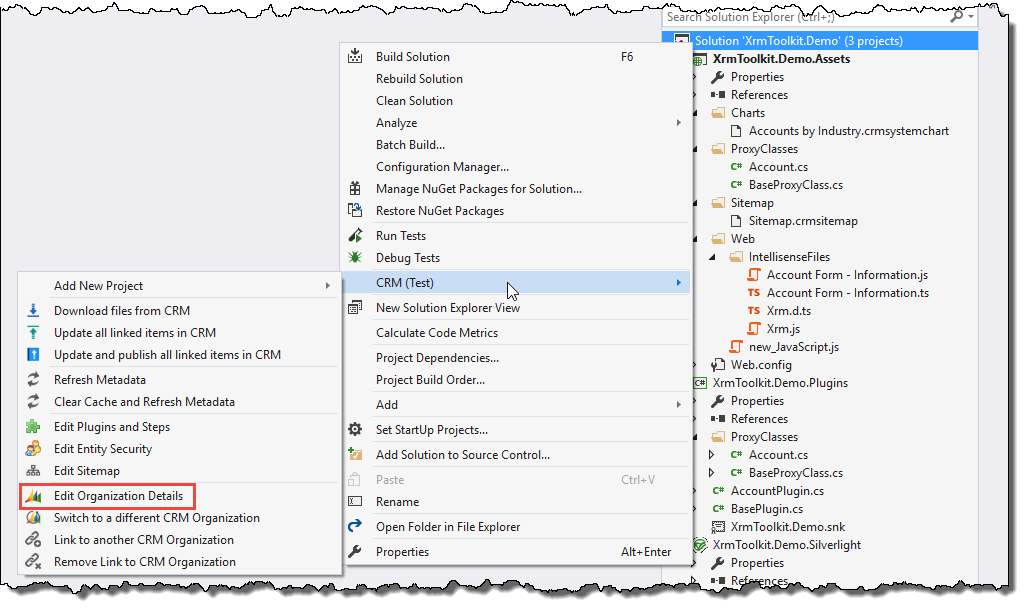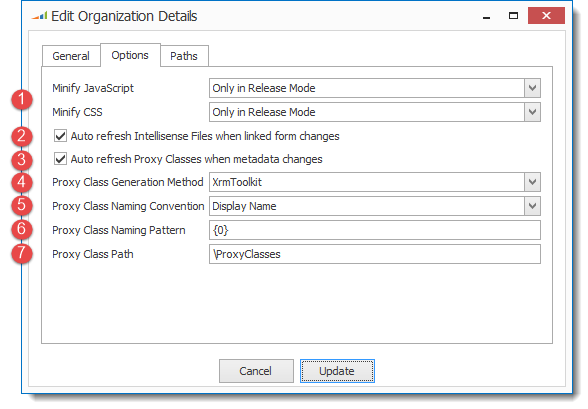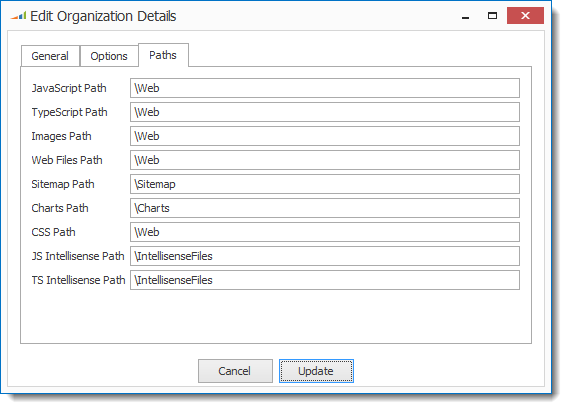Organization Settings.
You can change the different settings for the current organization by clicking on the 'Edit Organization Details' menu item shown here:

XrmToolkit will attempt to connect to the current organization in order to retrieve the available solutions. Then a window will appear with the following:
General Tab

- Display Name - This is the Display Name for the Organization in CRM.
- Name - This is the actual name of the Organization in CRM.
- User Friendly Name - This is the name used by XrmToolkit when displaying the Organization name throughout the menus and other areas.
- Organization URL - This is the URL used to connect to the organization.
- Discovery URL - This is the URL used to connect to the discovery service for the organization.
- Current Solution - This is the current working solution where all assets are added to when creating or publishing to CRM.
- You can remove all the links in the Visual Studio solution to the current organization by pressing this button.
Options Tab

-
JavaScript and CSS minification can occur in the following situations when a file is published to CRM:
- Never
- Always
- Only in Release Mode
The defaults for these come from the global settings here. This setting is applied to each JavaScript or CSS file that is downloaded during this process.
Once the file has been setup, this setting can be changed on a file-by-file basis. For more information see the documentation here.
-
When the metadata is either manually or automatically refreshed, XrmToolkit also checks for changes made to any linked forms for which there are intellisense files,
either JavaScript or TypeScript. If there are changes and this option is checked, the intellisense files will automatically be updated to
reflect any changes to the linked form.
-
XrmToolkit stores both entity and attribute metadata from your linked CRM Organizations. To learn more see our documentation here. You can manually refresh
the metadata or the metadata is automatically refreshed when logging onto the organization depending on option number 3 here. When the metadata is refreshed
you can optionally choose to have any proxy classes that are linked in your solution automatically updated with any changes from the metadata.
-
XrmToolkit can generate proxy or early bound classes based on either the CrmSvcUtil program included in the CRM SDK or a custom generator used by XrmToolkit.
-
The early bound class names, properties and methods can be named using the following:
- Display Name
- Schema Name
- Logical Name
-
When generating proxy classes, you can choose to use the display names, or the logical names at both the class and property levels. This is a global setting that gets copied
to the project level when creating new projects. You can also change this setting at the time that you download any new proxy classes. For more information see the documentation
here.
You can also optionally specify a specific naming pattern when generating the proxy class names. The default is to just use either the display name or logical name depending on
the setting above. You can specify a prefix or suffix by changing the naming pattern. For example, if you wanted the class name to be [Display Name]Entity then you would specify
{0}Entity as the naming pattern.
- You can specify the sub-folder that is used as the default for placing all the early bound classes.
Paths Tab

You can specify the default paths used for storing all the assets when XrmToolkit downloads them into your solution.



